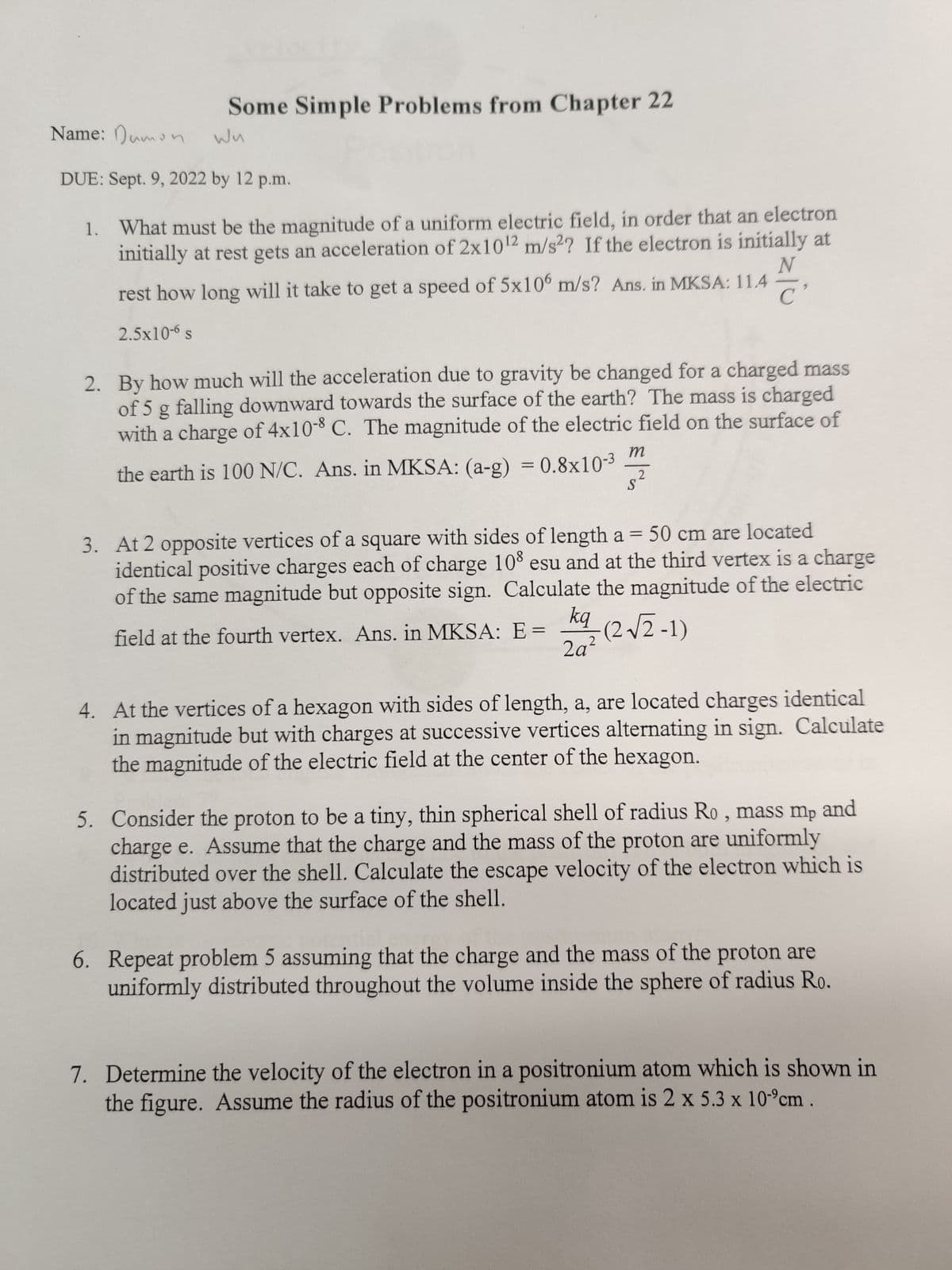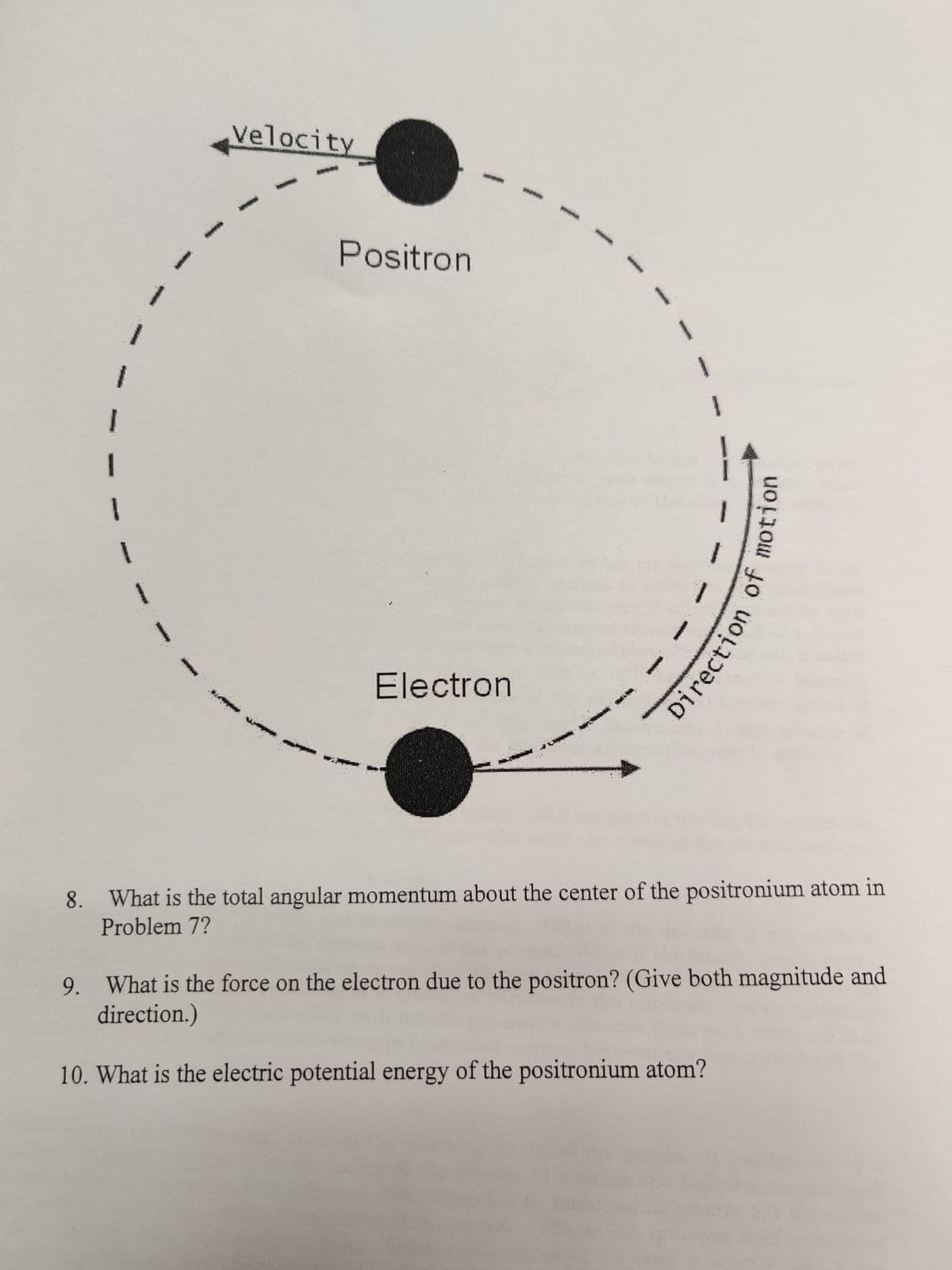2.5x10-6 s 2. By how much will the acceleration due to gravity be changed for a charged mass of 5 g falling downward towards the surface of the earth? The mass is charged with a charge of 4x10-8 C. The magnitude of the electric field on the surface of the earth is 100 N/C. Ans. in MKSA: (a-g) = 0.8x10-³ m S
2.5x10-6 s 2. By how much will the acceleration due to gravity be changed for a charged mass of 5 g falling downward towards the surface of the earth? The mass is charged with a charge of 4x10-8 C. The magnitude of the electric field on the surface of the earth is 100 N/C. Ans. in MKSA: (a-g) = 0.8x10-³ m S
College Physics
1st Edition
ISBN:9781938168000
Author:Paul Peter Urone, Roger Hinrichs
Publisher:Paul Peter Urone, Roger Hinrichs
Chapter30: Atomic Physics
Section: Chapter Questions
Problem 40PE: (a) What is the magnitude of the angular momentum for an l=1 electron? (b) Calculate the magnitude...
Related questions
Question
100%
Can you please solve problem 2, thanks!

Transcribed Image Text:Some Simple Problems from Chapter 22
Wu
Name: Dumon
DUE: Sept. 9, 2022 by 12 p.m.
1. What must be the magnitude of a uniform electric field, in order that an electron
initially at rest gets an acceleration of 2x10¹2 m/s2? If the electron is initially at
N
rest how long will it take to get a speed of 5x106 m/s? Ans. in MKSA: 11.4
2.5x10-6 s
2. By how much will the acceleration due to gravity be changed for a charged mass
of 5 g falling downward towards the surface of the earth? The mass is charged
with a charge of 4x10-8 C. The magnitude of the electric field on the surface of
the earth is 100 N/C. Ans. in MKSA: (a-g) = 0.8x10-³
m
2
S
3. At 2 opposite vertices of a square with sides of length a = 50 cm are located
identical positive charges each of charge 108 esu and at the third vertex is a charge
of the same magnitude but opposite sign. Calculate the magnitude of the electric
field at the fourth vertex. Ans. in MKSA: E=(2√2-1)
2a²
4. At the vertices of a hexagon with sides of length, a, are located charges identical
in magnitude but with charges at successive vertices alternating in sign. Calculate
the magnitude of the electric field at the center of the hexagon.
5. Consider the proton to be a tiny, thin spherical shell of radius Ro, mass mp and
charge e. Assume that the charge and the mass of the proton are uniformly
distributed over the shell. Calculate the escape velocity of the electron which is
located just above the surface of the shell.
6. Repeat problem 5 assuming that the charge and the mass of the proton are
uniformly distributed throughout the volume inside the sphere of radius Ro.
7. Determine the velocity of the electron in a positronium atom which is shown in
the figure. Assume the radius of the positronium atom is 2 x 5.3 x 10 cm

Transcribed Image Text:*
Velocity
p
Positron
Electron
Direction of motion
8. What is the total angular momentum about the center of the positronium atom in
Problem 7?
9. What is the force on the electron due to the positron? (Give both magnitude and
direction.)
10. What is the electric potential energy of the positronium atom?
Expert Solution
This question has been solved!
Explore an expertly crafted, step-by-step solution for a thorough understanding of key concepts.
Step by step
Solved in 2 steps with 1 images

Knowledge Booster
Learn more about
Need a deep-dive on the concept behind this application? Look no further. Learn more about this topic, physics and related others by exploring similar questions and additional content below.Recommended textbooks for you

College Physics
Physics
ISBN:
9781938168000
Author:
Paul Peter Urone, Roger Hinrichs
Publisher:
OpenStax College

Astronomy
Physics
ISBN:
9781938168284
Author:
Andrew Fraknoi; David Morrison; Sidney C. Wolff
Publisher:
OpenStax

Classical Dynamics of Particles and Systems
Physics
ISBN:
9780534408961
Author:
Stephen T. Thornton, Jerry B. Marion
Publisher:
Cengage Learning

College Physics
Physics
ISBN:
9781938168000
Author:
Paul Peter Urone, Roger Hinrichs
Publisher:
OpenStax College

Astronomy
Physics
ISBN:
9781938168284
Author:
Andrew Fraknoi; David Morrison; Sidney C. Wolff
Publisher:
OpenStax

Classical Dynamics of Particles and Systems
Physics
ISBN:
9780534408961
Author:
Stephen T. Thornton, Jerry B. Marion
Publisher:
Cengage Learning

Physics for Scientists and Engineers
Physics
ISBN:
9781337553278
Author:
Raymond A. Serway, John W. Jewett
Publisher:
Cengage Learning

Physics for Scientists and Engineers with Modern …
Physics
ISBN:
9781337553292
Author:
Raymond A. Serway, John W. Jewett
Publisher:
Cengage Learning

University Physics Volume 1
Physics
ISBN:
9781938168277
Author:
William Moebs, Samuel J. Ling, Jeff Sanny
Publisher:
OpenStax - Rice University